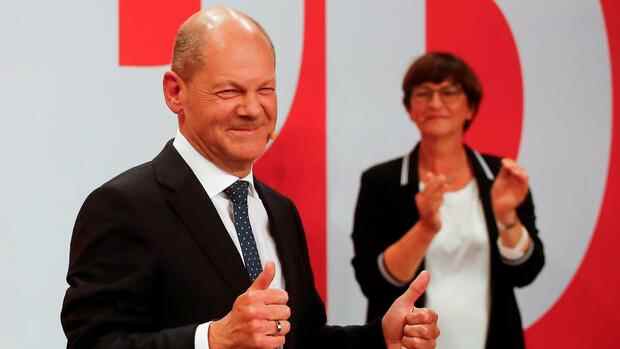Berlin On the Monday after the federal election, in which the SPD left the valley of tears and became the strongest force, its chancellor candidate Olaf Scholz paints a visionary picture: “When three parties that have an eye on progress at the beginning of the 1920s can work together that will be something good, even if they have different starting points for it. “It is about a” progress story “that the incumbent Vice Chancellor would like to write together with the Greens and the FDP as soon as possible.
The two parties – third and fourth place in the election – can feel flattered. In a traffic light coalition led by Scholz, they can hope for prominent posts in the federal cabinet. But even CDU chancellor candidate Armin Laschet has not given up hope for a Jamaica coalition despite disastrous losses.
On the evening of the election, he spoke on the phone with Scholz, Laschet and Green Party leader Robert Habeck, said FDP leader Christian Lindner – and the Liberals could continue to imagine a coalition with all of them. Habeck said that there was a certain logic towards a traffic light due to the election result. “But that doesn’t mean that we won’t talk to the Union.”
Election winner Scholz is therefore accelerating: “We will very quickly agree on the course of talks with the other parties with whom we want to form a government,” he said after the SPD presidium meeting.
Top jobs of the day
Find the best jobs now and
be notified by email.
Scholz did not reveal a schedule. Also not whether he has already spoken to Lindner and the Green Chancellor candidate Annalena Baerbock – which many in the SPD assume.
Exploratory team of the Social Democrats stands
A six-person exploratory team is to hold initial talks with the two preferred partners for the SPD. According to information from participants, the party executive decided that in addition to Scholz and the two party leaders Saskia Esken and Norbert Walter-Borjans, Secretary General Lars Klingbeil, parliamentary group leader Rolf Mützenich and the Rhineland-Palatinate Prime Minister Malu Dreyer will also be there. No red lines should be formulated before the discussions.
Before the courted Greens and Liberals engage in talks with the SPD or the Union, they first want to explore overlaps with each other. There will be a “very small circle” with the FDP about a common government, announced Green parliamentary group leader Anton Hofreiter. “We will see there. What do you have in common? What does the other side promise so that it can work? ”
The FDP boss expressed doubts about a traffic light coalition on Monday.
(Photo: dpa)
It makes sense that the FDP and the Greens, as parties in the middle, which are the most divergent in terms of content, first discussed possible common points, said Lindner. When it comes to issues such as climate protection, they agree on the goal, but not on the methods: “We represent the technological model, while the Greens make a lifestyle question out of it.”
Habeck also does not believe that his party will come together with the liberals: In social or economic policy, the potential partners are far apart: “This is where worlds collide.” On the other hand, there are overlaps in topics such as digitization, Europe or in the housing policy. In addition, it should also be about ministerial posts. Both parties want to provide the finance minister.
Read more about the federal election:
Everything should go better this time than in the failed Jamaica explorations in 2017, which many Greens remember with horror. They failed mainly because of differences in content with the FDP. The conversations went wrong at the time, “because everything was constantly being divulged,” said Habeck. It is advisable for everyone involved “not to carry everything they know on the tongue and to the market”.
The Greens are now the third strongest force in Germany.
(Photo: AP)
Habeck therefore did not comment on whether there had already been talks with the FDP. Lindner was also unable to elicit any details about the schedule on Monday. He wants to hold talks with the Green leadership together with FDP General Secretary Volker Wissing.
If the two smaller parties come to an agreement, they would be chancellor makers – and could choose their coalition partner. Green Chancellor candidate Baerbock had already emphasized the proximity to the SPD before the election and wanted the Union to join the opposition. “The CDU has clearly lost the election, so it is of course easier to convey an alliance with the SPD to the voters,” says the economic policy spokeswoman for the Green parliamentary group, Katharina Dröge.
Jamaica is a realistic option for some greens
Despite the clear tendency for the traffic light, Jamaica is still a realistic option for the Greens. There are definitely Greens who prefer an alliance with the Union because the constellation governs successfully in countries like Schleswig-Holstein. In any case, the future coalition must be an alliance “with a common narrative” in which everyone has “their own space”: Nobody wants a “coalition to fight,” says Dröge.
Scholz sees it similarly: It is “completely okay” if the FDP and the Greens talk to each other first. “I would like to form a government that is based on trust.” It is very clear, however, that the SPD, FDP and the Greens, as the winners of the elections, have the mandate to form a government.
The FDP reminded Scholz of the “very successful social-liberal coalition” under the SPD Chancellors Willy Brandt and Helmut Schmidt. In contrast, the black-yellow alliance from 2009 to 2013 was a “deterrent example”.
More: Guest comment: Golden Bridge for the FDP: The traffic light coalition is the only option
